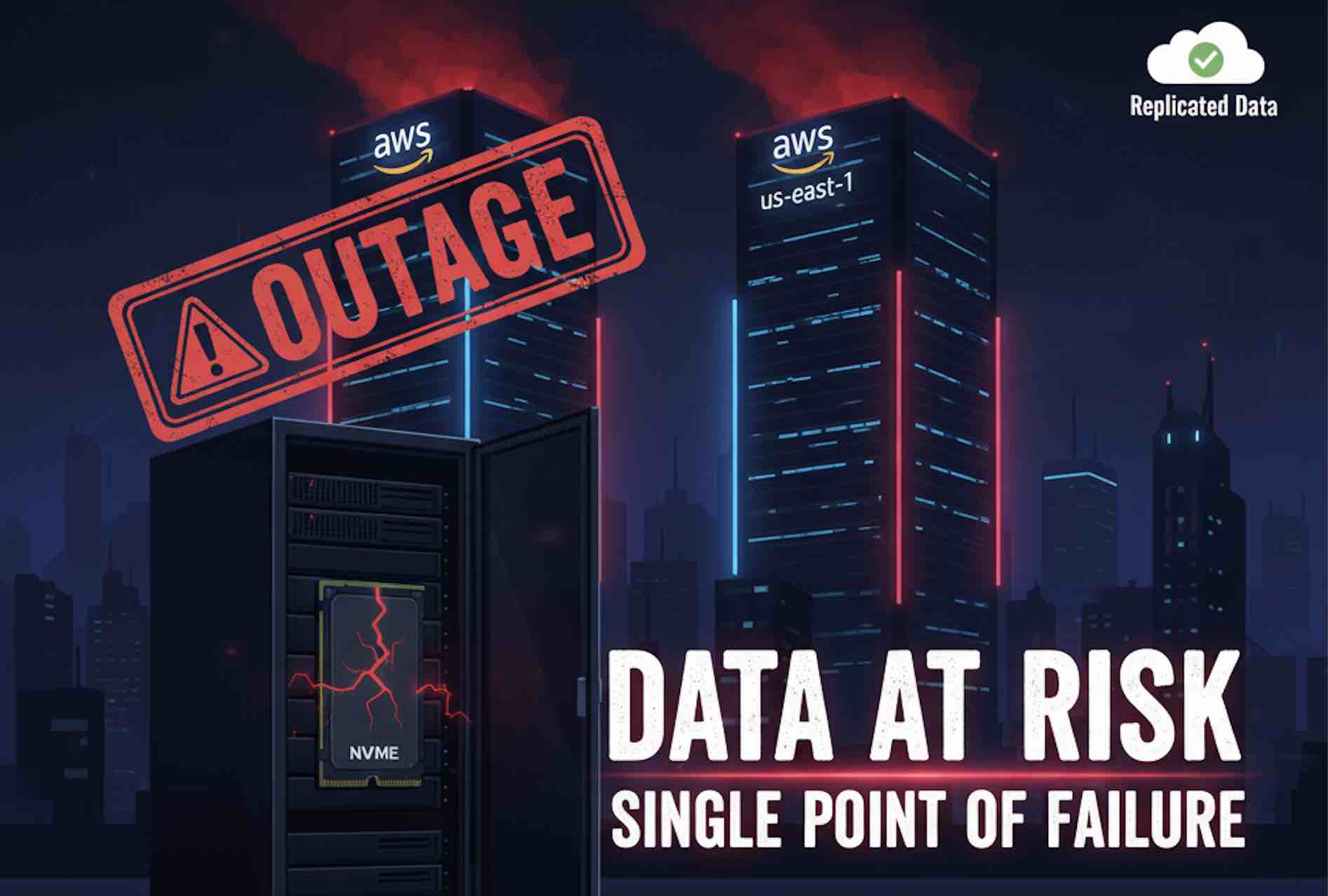Lessons from the AWS us-east-1 Outage: Why Local NVMe as Primary DB Storage Is Risky
On October 20, 2025, AWS experienced a major disruption across multiple services in the us-east-1 region. According to AWS Health Status, various compute, storage, and networking services were impacted simultaneously. For many teams running OLTP databases on instances backed by local NVMe, this was not just a downtime problem-it was a data durability nightmare.

Cloud databases must constantly balance durability, performance, and cost. In modern cloud environments, there are three main types of storage available:
| Storage Type | Durability | Latency | Cost | Persistence Across VM Crash |
|---|---|---|---|---|
| Block Storage (EBS) | High | Medium | High | Data persists |
| Local NVMe | None | Ultra-fast | Low per IOPS | Lost on restart/crash |
| Object Storage (S3) | Very High | Slow | Lowest | Persistent |
Let’s break down the trade-offs and why recent events place a spotlight on risky architectural choices.
Option 1: Block-Level Storage (EBS) - Durable but Expensive and Slow
EBS is the default choice for reliability:
- It survives instance failures.
- It supports cross-AZ replication via multi-replica setups.
- It enables quick reattachment to replacement nodes.
But the downside?
- GP2/GP3 disks deliver modest IOPS and high latency.
- High-performance variants like IO2 are extremely expensive when provisioned for hundreds of thousands of IOPS.
- Scaling performance often means scaling cost linearly.
EBS gives you durability-but performance per dollar is disappointing.
Option 2: Local NVMe - Fast but Ephemeral (and Now Proven Risky)
Instance families like i4i provide 400K+ to 1M+ IOPS from local NVMe, making them a natural fit for databases chasing performance.
So many database vendors recommend:
- Use local NVMe for primary storage
- Add cross-AZ replicas for durability
But here’s the problem: Local NVMe is tied to the node lifecycle. If the node restarts, fails, gets terminated due to spot interruption, or is impacted by a region-level failure such as the recent us-east-1 outage-you lose ALL the data.
During routine failures, cross-AZ replicas often protect you. But during region-wide degradation or cascading incidents, with local NVMe, there is nothing to recover. The storage is simply gone. What you can do is to recovery from recent backups - often lagging days. Write loss is guaranteed between last backup and crash.
In contrast, EBS volumes can always be reattached to a new node.
The AWS us-east-1 outage just validated that “local NVMe + async replication” is a high-risk strategy for mission-critical databases.
Option 3: Object Storage (S3) - Durable & Cheap, But Latency Is a Challenge
Object storage is:
- 3x cheaper than block storage
- Regionally and cross-region durable
- Built to survive region-level failures
- Practically infinite
- A first-class citizen for modern cloud-native platforms
But the challenge remains: S3 latency is too high for OLTP if accessed synchronously.
This is why traditional OLTP engines avoid it.
So the question becomes: How do we get the cost & durability benefits of S3 without paying the latency penalty?
The Data Substrate Approach: Object Storage First, NVMe as Cache, EBS for Logs
EloqData treats object storage (e.g., S3) as the primary data store, and architect the system to avoid the usual latency pitfalls:
| Layer | Role | Why |
|---|---|---|
| S3 (Object Storage) | Primary data store | Ultra-durable, Cheap |
| EBS (Block Storage) | Durable log storage | Small volume, low latency writes |
| Local NVMe | High-performance cache | Accelerates reads & async flushes |
Through Data Substrate, we decouple storage from compute and split durability between:
- Log: persists immediately to EBS
- Data store: periodically checkpointed to S3 (async + batched)
- NVMe: purely a cache layer, safe to lose at any time
This allows us to:
- Withstand node crashes seamlessly
- Recover fully even if local NVMe is wiped
- Handle region-level disruption by replaying logs and checkpoints
- Enjoy millions of IOPS from NVMe without durability risk
- Cut storage cost by 3x+ compared to full EBS-based systems
Check out more on our products powered by Data Substrate:
The Larger Industry Trend
We are not alone in this shift. The broader ecosystem is moving object-storage-first:
| System | Use of Object Storage |
|---|---|
| Snowflake | OLAP on S3 |
| StreamNative Ursa | Streaming data on S3 |
| Confluent Freight Clusters | Streaming data on S3 |
| Turbopuffer | Vector & full-text search on S3 |
EloqData brings this model to OLTP with a transactional, low-latency engine powered by Data Substrate.
After the Outage: A Hard Question Every Architect Should Ask
If my database node died right now, would I lose all my data?
If you're running a primary database on local NVMe, and relying solely on async replicas, the answer might be yes.
It’s time to rethink durability assumptions in the cloud era.
Summary
| Strategy | Performance | Durability | Region Outage Risk | Cost |
|---|---|---|---|---|
| EBS only | Medium | ✅ | ✅ | $$$ |
| Local NVMe only | Fast | ❌ | ❌ | $$ |
| NVMe + async replicas | Fast | Partial | High | $$ |
| Object Storage + Log + NVMe Cache (EloqData) | Fast | ✅✅ | ✅✅ | $ |
AWS us-east-1 just reminded the industry: Performance is replaceable. Lost data is not.
With the right architecture, you don’t have to choose.
- Build fast.
- Stay durable.
- Be outage-proof.
That’s the future we’re building at EloqData.
Check out more on our open source databases:
